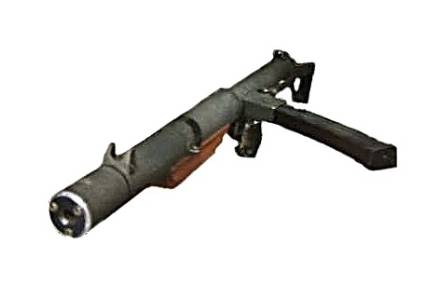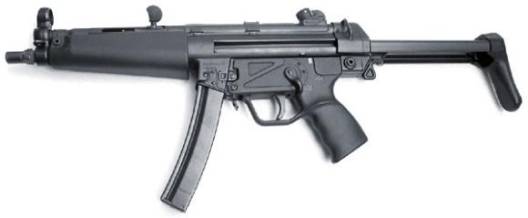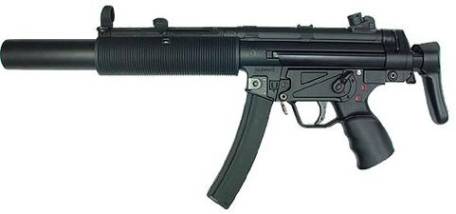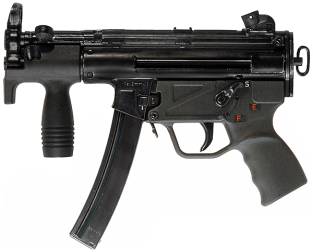SUB-MACHINE GUNS
L2A3 Sterling Sub Machine Gun

| Calibre: | 9mm | Muzzle Velocity: | 390m/s |
| Weight: | 2.7kg | Length: | 0.69m |
| Magazine Capacity: | 34 rounds | Rate of Fire: | cyclic 550 rounds/min |
| Effective Range: | 200m | Date in Service: | 1956/h |
The famous Sterling submachine gun was born in around 1942 as "Patchett machine carbine" -
a prototype submachine gun, developed by George W. Patchett and originally produced by Sterling
Engineering Co in England. Several prototypes were built before the end of the war, and the
Sterling-Patchett submachine gun participated in extensive trials, held in UK between 1945 and 1953,
when it was finally announced as a winner of trials, and adopted as "9mm Sterling submachine gun L2A1"
(factory designation was "Patchett Mk.1"). Sterling submachine guns were produced for British
armed forces by Sterling Armament Company, England.
The Sterling L2A1 was adoped by the British Army in 1953, the L2A2 Mk3 which featured some minor modifications
came into service in 1955, and the L2A3 in 1956. Known in the British Army as L2A3 SMG or as the Sterling Mk.4, it served
with British army until early 1990s, when, with the introduction of the L85A1 assault rifle, it was finally replaced. Nearly
400,000 Sterling SMG's were produced between 1953 and the late 1980's.
Sterling submachine guns also were widely sold for export, more than 70 countries had purchased various quantities of
Sterling SMG's. Sterling submachine guns were rather popular among British troops, because of relatively compact size,
adequate firepower and accuracy, and good reliability.
The Sterling submachine gun is constructed entirely of steel and has a shoulder stock which folds underneath the weapon.
Although of conventional blowback design firing from an open bolt, there are some unusual features:
for example, the bolt has helical grooves cut into the surface to remove dirt and fouling from the inside of the receiver to increase reliability. The
Sterling uses a much-improved (over the Sten) 34-round curved double-column feed box magazine which is inserted into the left
side of the receiver. The magazine follower, which pushes the cartridges into the feed port, is equipped with rollers to reduce
friction and the firing pin is designed so that it does not line up with the primer in the cartridge until the cartridge has entered the chamber.
L34A1 Suppressed Sterling Sub Machine Gun Mk5

The suppressed version of the Sterling (L34A1/Mk.5) was developed for covert operations. This version uses a ported barrel surrounded
by a cylinder with expansion chambers to reduce the velocity of the bullet to prevent it from breaking the sound barrier and causing a
sonic boom, along with decreasing muzzle blast and flash. This is so effective that the only sounds during firing are from the bolt
reciprocating and the barely audible explosive discharge. The Australian and New Zealand SAS regiments used the suppressed version of
the Sterling during the Vietnam War. It is notable for having been used by both Argentinian and British Special Forces during the Falklands War.
It was also the weapon used by Libyan agents to kill WPC Yvonne Fletcher outside the Libyan Embassy in London which sparked the 1984 siege
of the building.
The Sterling has a reputation for excellent reliability under adverse conditions and, even though it fires from an open bolt, good accuracy. With
some practice, it was very accurate when fired in short bursts. While it has been reported that the weapon poses no problems for left-handed users
to operate, it is not recommended without the wearing of ballistic eye protection. The path of the ejected cartridge cases is slightly down and
backward, so mild burns can occasionally be incurred by left-handed shooters.
A bayonet of a similar design as that for the L1A1 SLR was produced and issued in British Army service, but was rarely employed except for ceremonial
duties. Both bayonets were derived from the version issued with the Rifle No. 5 Mk 1 "Jungle Carbine", the main difference being a smaller ring on the
SLR bayonet to fit the rifle's muzzle. When mounted, the Sterling bayonet was offset to the left of the weapon's vertical line which gave a more
natural balance when used for bayonet-fighting.
For a right-handed shooter, the correct position for the left hand while firing is on the ventilated barrel-casing but not on the magazine, as
the pressure from holding the magazine can increase the risk of stoppages, and a loose magazine can lead to dropping the weapon. The barrel-casing
hold provides greater control of the weapon, so the right-hand can intermittently be used for other tasks. A semi-circular protrusion on the right
hand side of the weapon, approximately two inches from the muzzle, serves to prevent the supporting hand from moving too far forward and over the muzzle.
The primary user complaint with the Sterling series is that there are projections in all directions, and carrying it on a sling frequently
results in the weapon catching on clothing, load-bearing equipment, foliage, and doorways/hatches, as well as annoying (sometimes painful)
poking of the user.
A total of over 400,000 were manufactured. Sterling built them for the British armed forces and for overseas sales, whilst the Royal Ordnance
Factories at Fazakerley near Liverpool constructed them exclusively for the British military. ROF no longer makes full weapons but still manufactures
spare parts for certified end users.
A Chilean variant was made by FAMAE as the PAF submachine gun but was different externally as it had a shorter receiver lacking the barrel
shroud.
Canada also manufactured a variant under licence, called the Submachine Gun 9 mm C1 made by Canadian Arsenals Limited. It replaced the later
versions of the Sten submachine gun from 1953 onwards.
L91A1 Heckler & Koch MP5A3 Sub Machine Gun

| Calibre: | 9mm | Muzzle Velocity: | 400m/s |
| Weight: | 2.5kg | Length: | 0.686m |
| Magazine Capacity: | 15/30 rounds | Rate of Fire: | cyclic 800 rounds/min |
| Effective Range: | 200m | Date in Service: | 1976/h |
The Heckler & Koch MP5 (from German: Maschinenpistole 5, "machine pistol model 5") is a 9mm submachine gun of German design, developed in the
1960’s by a team of engineers from the German small arms manufacturer Heckler & Koch GmbH (H&K) of Oberndorf am Neckar. There are over 100 variants
of the MP5, including a semi-automatic version.
The British Armed Forces adopted 3 Variants of the MP5, the MP5A3 designated L91A1, the MP5K designated L80A1 & the MP5SD3 designated L92A1.
The MP5 is one of the most widely used submachine guns in the world, having been adopted by 40 nations and numerous military, law enforcement, intelligence, and security organizations.
In 1980, the MP5 achieved iconic status as a result of its use by SAS commandos in Operation Nimrod, where they stormed the Iranian Embassy in
London, rescuing hostages and killing five terrorists. The MP5 became a mainstay of SWAT units of law enforcement agencies in the United States
since then. However in the late 1990’s, as a result of the North Hollywood shootout, police special response teams have supplanted some MP5s with
AR-15-based assault rifles.
The MP5 is manufactured under license in several nations including Greece (formerly at EBO – Hellenic Arms Industry, currently at EAS – Hellenic
Defense Systems), Iran (Defense Industries Organization), Mexico (SEDENA), Pakistan (Pakistan Ordnance Factories), Saudi Arabia, Sudan (Military
Industry Corporation), Turkey (MKEK), and the United Kingdom (initially at Royal Ordnance, later diverted to Heckler & Koch Great Britain).
The primary version of the MP5 family is the MP5A2, which is a lightweight, air-cooled, selective fire delayed blowback operated 9×19mm Parabellum
weapon with a roller-delayed bolt. It fires from a closed bolt (bolt forward) position.
The fixed, free floating, cold hammer-forged barrel has 6 right-hand grooves with a 1 in 250mm (1:10 in) rifling twist rate and is pressed and
pinned into the receiver.
MP5SD3 L92A1
In 1974 H&K initiated design work on a sound-suppressed variant of the MP5, designated the MP5SD (SD—Schalldämpfer German for "sound suppressor"), which
features an integral but detachable aluminium sound suppressor and a lightweight bolt. The weapon's 146mm (5.7 in) barrel has 30 2.5mm (0.1 in) ports
drilled forward of the chamber through which escaping gases are diverted to the surrounding sealed tubular casing that is screwed onto threading on the
barrel’s external surface just prior to the ported segment. The suppressor itself is divided into two stages; the initial segment surrounding the ported
barrel serves as an expansion chamber for the propellant gases, reducing gas pressure to slow down the acceleration of the projectile. The second,
decompression stage occupies the remaining length of the suppressor tube and contains a stamped metal helix separator with several compartments which
increase the gas volume and decrease its temperature, deflecting the gases as they exit the muzzle, so muffling the exit report. The bullet leaves the
muzzle at subsonic velocity, so it does not generate a sonic shock wave in flight. As a result of reducing the barrel’s length and venting propellant
gases into the suppressor, the bullet’s muzzle velocity was lowered anywhere from 16% to 26% (depending on the ammunition used) while maintaining the
weapon’s automation and reliability. The weapon was designed to be used with standard supersonic ammunition with the suppressor on at all times.
L92A1 Heckler & Koch MP5SD3 Sub Machine Gun

The MP5SD is produced exclusively by H&K in several versions: the MP5SD1 and MP5SD4 (both have a receiver end cap instead of a buttstock), MP5SD2 and
MP5SD5 (equipped with a fixed synthetic buttstock) and the MP5SD3 and MP5SD6 (fitted with a collapsible metal stock). The MP5SD1, MP5SD2 and MP5SD3
use a standard "SEF" trigger group (from the MP5A2 and MP5A3), while the MP5SD4, MP5SD5 and MP5SD6—a trigger module with a mechanically limited 3-round
burst mode and ambidextrous selector controls (from the MP5A4 and MP5A5). A suppressed version was produced for the U.S. Navy – designated the MP5SD-N,
which is a version of the MP5SD3 with a retractable metal stock, front sight post with tritium-illuminated dot and a stainless steel suppressor. This
model has a modified cocking handle support to account for the slightly larger outside diameter of the suppressor. The design of the suppressor allows
the weapon to be fired with water inside, should water enter the device during operation in or near water.
MP5K L80A1
In 1976 a shortened version of the MP5A2 was introduced; the MP5K (K from the German word Kurz = "short") was designed for close quarters
battle use by clandestine operations and special services. The MP5K does not have a shoulder stock (the receiver end was covered with a flat end cap,
featuring a buffer on the inside and a sling loop on the outside), and the bolt and receiver were shortened at the rear. The resultant lighter bolt
led to a higher rate of fire than the standard MP5. The barrel, cocking handle and its cover were shortened and a vertical foregrip was used to
replace the standard handguard. The barrel ends at the base of the front sight, which prevents the use of any sort of muzzle device.
L80A1 Heckler & Koch MP5K Sub Machine Gun

The MP5K is produced (by Heckler & Koch and under license in Iran and Turkey) in four different versions: the MP5K, MP5KA4, MP5KA1, MP5KA5, where the first two variants have adjustable, open-type iron sights (with a notched rotary drum), and the two remaining variants – fixed open sights; however, the front sight post was changed and a notch was cut into the receiver top cover. The MP5K retained the capability to use optical sights through the use of an adapter.